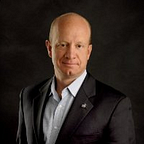Two Struggles I’ve Faced While Building a Personal Brand
We’ve always had thought leadership, but modern technology means we make them differently. How do you stand out?
Personal branding, defined and as a subset of marketing, is a relatively new venture.
Really, it has been done incidentally for decades. Let’s face it: We all have a personal brand. We all should have been managing them better.
The fact that the digital universe now allows our personal brands to be more front-and-center than the old school pen-and-paper days doesn’t change the fact that personal branding, as a concept, isn’t new.
Its acceleration, by virtue of the tools and platforms we now have access to, has simply made it more obvious.
Here’s the problem with personal branding, and some of my experiences as I have attempted to engage in it.
Number one.
Anything that’s new (think of the .com era in the late 90’s) creates a little bit of a Wild West environment: whoever has the loudest megaphone and thinks they know the answer becomes the resident expert.
I think of a number of Super Bowl TV commercials from Pets.com, with the sock puppet. They were everywhere, making all the noise. Where are they now? They no longer exist.
Other companies from that era stayed focused on fundamental principles and understood that the technologies of the .com era were new tools for the toolkit. Where are they now? They’re still around.
But the old tools and discipline still apply. The ones who realized this are the heroes and the behemoths of today.
The same is true with personal branding. There was a lot of noise, a lot of wild west-ness going on with newfashioned personal branding. A lot of people that were loud had no substance, all hat no cattle, all sizzle no steak.
From that noise will arise the responsible adults who understand that this is just a new discipline that plays by the same rules, and that the principles of business and marketing still apply. It’s just a new avenue for their use and personification.
So, be wary of those that are loudest in the short term, particularly in brand new industries.
Another example is how many people in the personal branding marketplace focus on followership. That, in my opinion, misses the point.
Followership doesn’t equal influence.
There is no point in having a gazillion followers on Facebook if they’re all looky-loos who have no real desire to provide value to you or your business. This is usually the case if you offer nothing of value in your personal brand.
A lot of people confuse association with causation. Just because I have followers doesn’t mean I have influence. At the end of the day, a personal brand isn’t about the ego stroke of “look at all my followers,” it’s about “what influence do I have to move the masses or sell my product?”
One of the mistakes I’ve made, or rather, a couple of the mistakes I’ve made is stepping outside my realm of expertise. Whenever I attempt to step out of my lane, I am usually met with disaster or embarrassment. I know which areas I am competent and confident in, and that’s where I should build my personal brand.
If I stray too far away from my core competencies, my audience interaction becomes inconsistent. The message will be muddled and unclear. I confuse my audience as to what I stand for and what I’m about. In a world where your brand is owned by your consumers, confusing them isn’t a good way to build quickly. Instead, stay in your lane, define what your brand is about. Be “there.”
Yes, later on, from time to time, you can begin to branch out. “Let me opine on this subject over here, even though I’m out of my depth or expertise.” That can be part of the way that you build your brand.
Trying to be all things to all people, trying to be too broad before you’re too deep, is a mistake. I’ve learned that the hard way.
Number two.
I’ve mentioned this one before, and it’s more particularly obvious in companies that sell physical products: Your brand is not owned by the company; it’s not owned by you.
Your brand is owned by your customers.
When Nike or Gillette or whomever steps outside of their brand presence and starts playing in sand boxes that aren’t perceived by their customers as “their space,” it creates confusion and dissonance amongst their customers. That confusion causes disengagement. The same thing is true with your personal brand. Stay true to what it is you want to be seen as a thought leader for. That way you build a true followership.
I’ve tried to stay true to this point whenever I publish an article. When I’ve written an article on subject A, and it’s received a good response, it has raised other issues tangential to it. I’ll do an article on A-1 and A-2 and so on. I exhaust topic A before I venture onto topics B, C and D.
The idea of having a central theme that you evolve from by leveraging your expertise, rather than leapfrogging around and trying to be all things to all people, is a sound principle relative to building your brand.
At the end of the day, it’s about iterating in a consistent direction, the more often and the more consistently you do that creates a drumbeat. It almost becomes boring. That’s when you know you’ll begin to build a brand.
When the expectation of your followers is being met by your delivery, then you know that you’re on brand and are reinforcing your previous work and it’s compounding to your benefit.
Aaron Webber is a serial entrepreneur and CEO of Webber Investments LLC, as well as a Managing Partner at Madison Wall Agencies.
If you liked this post, please press the clap button and leave any questions or comments below.
